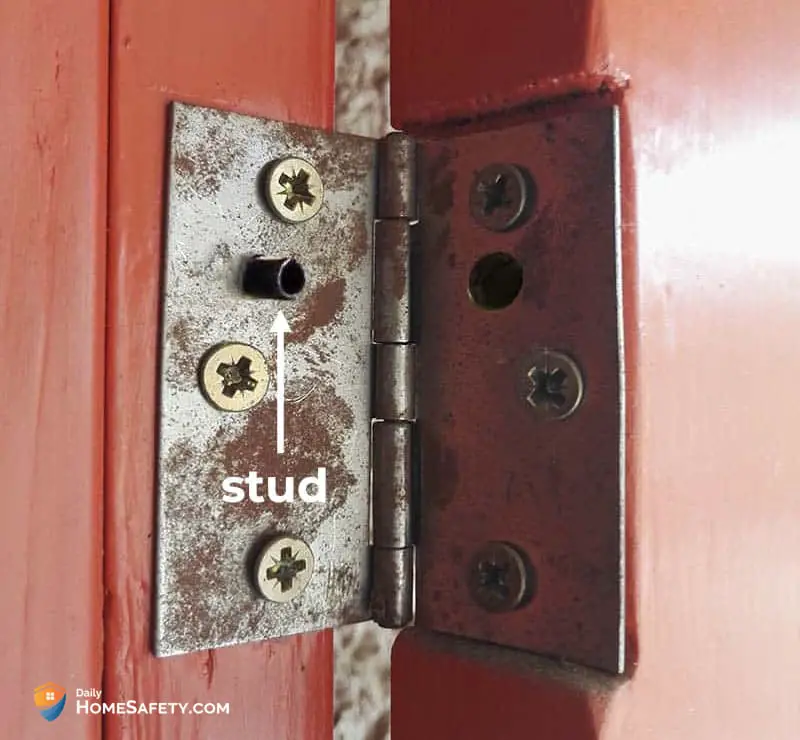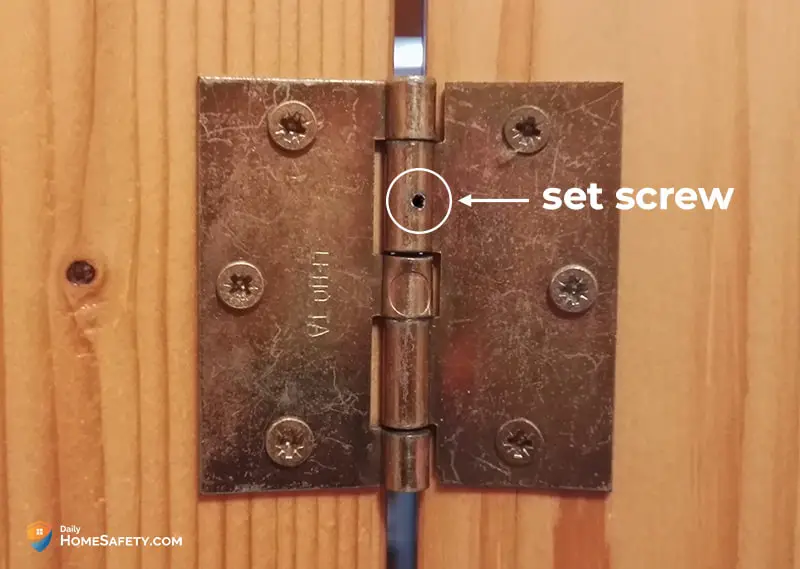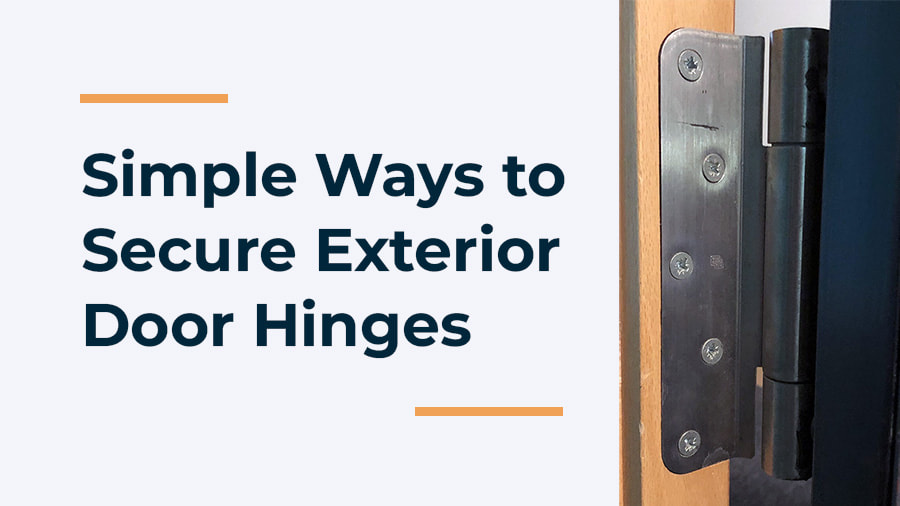No matter how strong and secure a door is, if the hinges are on the outside without any proper reinforcement, it is usually only a matter of seconds before a burglar removes the door from its place.
This is why you should never ignore securing exterior door hinges. In fact, if you have an outward opening door, I highly suggest you start upgrading your door security by reinforcing the hinges.
I cannot stress enough how important this is.
Fortunately, there are some simple and effective methods that you can use without too much hassle in most cases.
Let’s see them one by one.
1. Add Studs to the Hinges
Most hinges come with removable pins that make them extremely vulnerable. Once the pin is removed, anyone can easily gain entry regardless of how secure the deadbolt you use is.
In fact, it’s pretty easy to remove those pins. All you need is a screwdriver (or a Vise-Grip) and a hammer. Even burglars with little to no experience can do it. Outside hinges with removable pins are a particular concern for outswing doors where the hinge pins are exposed.
However, if there’s something that keeps the hinged side of the door in place (even without the pins), that’s a whole different story.
This is where adding studs to the hinges comes in.
The idea behind this hack is that you can prevent a door from moving in any direction (in a closed position) by attaching the hinge leaf that’s mounted on the jamb to the leaf on the door using a solid stud that’s engaged into both sides when the door is closed.
Here’s what I’m talking about:

This way the door cannot be removed and stays in place even if the exterior hinge pins are popped.
To make this work, you’ll need to add studs to the hinges at the top and bottom (for more security, you can reinforce all hinges but it’s not strictly necessary).
Here’s what you’ll need:
- stud bolts or tension pins
- power drill
- drill bits of two different sizes (more on that later)
- hammer
- crayon or lipstick
You’ll need at least two studs or tension pins, one for the top hinge and one for the bottom hinge.
Also, you’ll need a drill bit with a diameter that is a little bit smaller than the diameter of the stud and another drill bit that’s slightly larger than the stud.
As a first step, you have to drill a hole into the hinge leaf that’s mortised into the door jamb using the smaller drill bit. The stud should stick out about ¼ inch, so you need to adjust the depth of the hole accordingly (a drill stop can be useful).
Next, you have to drive the stud into the hole with a hammer and then mark its end with a crayon or lipstick. Then close and open the door so that a mark appears on the opposite side of the hinge leaf. This way you’ll know exactly where to drill the second hole (using the larger drill bit).
That’s it. Now when you close the door, the stud anchors directly into the corresponding hole on the opposite side securing the exterior door hinges.
The main disadvantage of this method is that you have to be quite precise when drilling the holes. You should pay close attention to both the diameter and the depth of the holes.
FYI – If you want to secure an outward opening door, make sure you also check out this guide with some helpful tips.
As an alternative, you can also install the stud in an existing hole (by removing a hinge screw) but in most cases, you’ll still need to adjust the size of the hole.
If you want to make your life even easier and need a simpler solution, opt for these hardened security pins from Hingemate. These will make the whole process more straightforward.
If you don’t want to mess with the hinges, you can install jamb pins (similar to hinge bolts) above or below the hinges. When the door is closed, the jamb pins installed on the jamb will fit into the hole on the opposite side and keep the door in place. In fact, this is a rarely used but highly effective method to reinforce front doors.
2. Replace Your Existing Hinges with Security Hinges
Another great way to secure a door with hinges on the outside is to replace the old hinges with security hinges.
What is a security hinge?
In most cases, a security hinge looks very similar to an ordinary hinge, however, it comes with a unique security feature that makes removing the door really hard for thieves.
Basically, there are 4 main types of security hinges:
1. Stud Hinges
A security stud hinge features a tamper-proof stud that goes into a hole on the opposite side of the hinge keeping the two leaves together when the door is closed. Even if the hinge pin is popped from the barrel by a thief, the interlocking hinge leaves keep the door in place.
The main advantage of stud hinges is that when you want to remove the door, you can do it pretty easily without having to remove the hinge screws.
The drawback is that you have to drill holes into the door.
Example of a stud hinge:
2. Hinges with Non-Removable Pin (aka Fast-Riveted Hinges)
The main problem with exterior door hinges is that anyone can have access to them from the outside. The use of non-removable pins solves this issue by securing the exposed hinges.
The main disadvantage of riveted hinges is that they won’t allow you to remove the door from the hinges by removing the pin, so you have to unscrew the hinges from both the jamb and the door.
The major benefit is that you don’t have to drill holes for any studs.
Example of a hinge with a non-removable pin:
3. Set Screw Hinges
This type of hinge features a removable set screw that keeps the hinge pin in the barrel.
The set screw will prevent the removal of the pin when the door is closed, however, you can easily access the set screw and remove the pin when the door is open. This way unauthorized persons from the outside won’t have access to the set screw, therefore they won’t be able to remove the hinge pin.

4. Continuous Hinges (aka Piano Hinges)
Continuous hinges are not always considered security hinges, however, I decided to include them on the list because they provide way more security for an outward opening door than standard butt hinges.
Using security hinges is an effective way to reinforce not only outward swinging doors but also any exterior door.
While replacing the existing exterior door hinges with secure ones usually takes a little more time than adding a stud, there’s usually less room for errors.
Therefore, if you prefer straightforward solutions, I recommend you consider switching to security hinges. Make sure you follow the manufacturer’s instructions when installing new hinges.
Keep in mind that security hinges are no substitute for a good quality door lock. You need both for security.
Pro Tip: When installing the hinges, make sure the screws you use are at least 2 ½ inches long. Short (and weak) screws make the whole door vulnerable.
Here you’ll find the strongest types of hinges.
3. Secure the Hinge Pins with a Set Screw
While replacing an old hinge with a set screw hinge is an ideal and simple solution, in most cases you can modify your existing hinges to get a similar result.
Keep in mind that this is an advanced method, therefore I wouldn’t recommend it for newbie DIYers.
To secure an outside door hinge pin with a set screw, you need to drill a small hole through the barrel and the pin on the inside part of the hinge (so it’s not accessible from the outside when the door is closed).
Next, you have to insert the set screw into the hole and that will keep the pin in place even if someone is trying to remove it from the outside.
FYI – Sometimes you might need to secure a door without a lock. We’ve collected all the best methods in this article.
Putting It All Together
As you can see, there are several methods to secure a door with exterior hinges. If you need a straightforward solution, I suggest you install security hinges.
If you want to remove the door occasionally, opt for stud hinges (or set screw hinges).
Otherwise, installing fast-riveted hinges might be a simpler solution as you don’t have to drill extra holes for the studs.
If you like DIY projects, adding a stud to your existing hinges will save you from having to unscrew the existing hinges.
Whether you want to reinforce a residential or a commercial door, securing the hinges is a simple yet powerful way of preventing forced entries and improving overall security.
Don’t forget though, that you’ll still need to reinforce the door frame and get a high-quality door lock to prevent full-force attacks, such as kick-ins.













